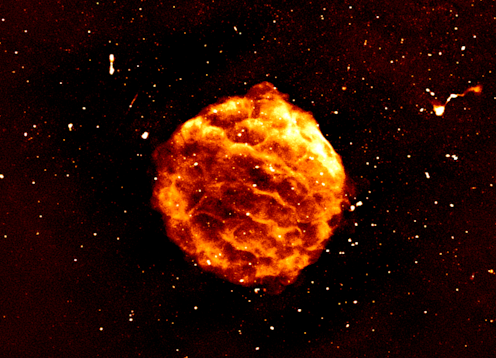A new Australian supercomputer has already delivered a stunning supernova remnant pic
- Written by Wasim Raja, Research scientist, CSIRO

Within 24 hours of accessing the first stage of Australia’s newest supercomputing system, researchers have processed a series of radio telescope observations, including a highly detailed image of a supernova remnant.
The very high data rates and the enormous data volumes from new-generation radio telescopes such as ASKAP[1] (Australian Square Kilometre Array Pathfinder) need highly capable software running on supercomputers. This is where the Pawsey Supercomputing Research Centre comes into play, with a newly launched supercomputer called Setonix[2] – named after Western Australia’s favourite animal, the quokka[3] (Setonix brachyurus).
ASKAP, which consists of 36 dish antennas that work together as one telescope, is operated by Australia’s national science agency CSIRO; the observational data it gathers are transferred via high-speed optical fibres to the Pawsey Centre for processing and converting into science-ready images.
In a major milestone on the path to full deployment, we have now demonstrated the integration of our processing software ASKAPsoft on Setonix, complete with stunning visuals.
Putting a supercomputer through its paces
The image of SNR G261.9+05.5 might be beautiful to look at, but the processing of data from ASKAP’s astronomy surveys is also a great way to stress-test the supercomputer system, including the hardware and the processing software.
We included the supernova remnant’s dataset for our initial tests because its complex features would increase the processing challenges.
Data processing even with a supercomputer is a complex exercise, with different processing modes triggering various potential issues. For example, the image of the SNR was made by combining data gathered at hundreds of different frequencies (or colours, if you like), allowing us to get a composite view of the object.
But there is a treasure trove of information hidden in the individual frequencies as well. Extracting that information often requires making images at each frequency, requiring more computing resources and more digital space to store.
While Setonix has adequate resources for such intense processing, a key challenge would be to establish the stability of the supercomputer when lashed with such enormous amounts of data day in and day out.
Key to this quick first demonstration was the close collaboration between the Pawsey Centre and the ASKAP science data processing team members. Our teamwork enabled all of us to better understand these challenges and quickly find solutions.
These results mean we will be able to unearth more from the ASKAP data, for example.
Read more: How Australia's supercomputers crunched the numbers to guide our bushfire and pandemic response[8]
More to come
But this is only the first of two installation stages for Setonix, with the second expected to be completed later this year.
This will allow data teams to process more of the vast amounts of data coming in from many projects in a fraction of the time. In turn, it will not only enable researchers to better understand our Universe but will undoubtedly uncover new objects hidden in the radio sky. The variety of scientific questions that Setonix will allow us to explore in shorter time-frames opens up so many possibilities.
This increase in computational capacity benefits not just ASKAP, but all Australia-based researchers in all fields of science and engineering that can access Setonix.
While the supercomputer is ramping up to full operations, so is ASKAP, which is currently wrapping up a series of pilot surveys and will soon undertake even larger and deeper surveys of the sky.
The supernova remnant is just one of many features we’ve now revealed, and we can expect many more stunning images, and the discovery of many new celestial objects, to come soon.
References
- ^ ASKAP (www.csiro.au)
- ^ newly launched supercomputer called Setonix (pawsey.org.au)
- ^ the quokka (australian.museum)
- ^ G261.9+5.5 (simbad.u-strasbg.fr)
- ^ first classified (doi.org)
- ^ Parkes Radio Telescope, Murriyang (www.csiro.au)
- ^ Curious Kids: If a star explodes, will it destroy Earth? (theconversation.com)
- ^ How Australia's supercomputers crunched the numbers to guide our bushfire and pandemic response (theconversation.com)

















